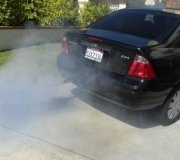Initial emissions scores at this stage were (HC-CO-NOx) 0.22, 6.03 & 0.29. PCV system was checked ok, I swapped in a used MAF and replaced the intake air temp sensor (much better low end & smoother power after) & retested. This produced scores of 0.42, 3.41 and 0.31. HC limit is 0.50, so I reinstalled the original MAF and retested (same day), and it scored 0.21, 6.31 and 0.20. With the new intake air temp sensor, this is its lowest NOx reading on record.
It seems odd that the different MAF would improve the CO but cause HC problems. Scores dating back to ~70k miles are consistently in the 0.3x / 6. Xx / 0.4x range. I have checked emissions scores on friends with the same engine, and their CO scores are much lower, usually < 3.
The car runs very well with the only annoying symptom being a bouncing idle after the car is restarted when warm, but the elevated CO levels concern me. The idle is very smooth once the bouncing stabilizes. Power builds smoothly to redline, the motor has virtually no oil consumption, and compression tests were near perfect.
SPONSORED LINKS
Tuesday, April 28th, 2009 AT 1:17 AM




